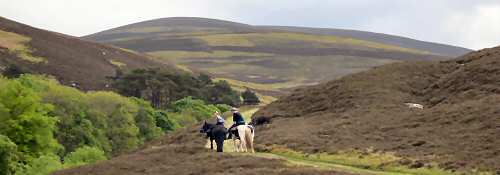Using the Trails
Walkers can enjoy the SoSCT network throughout the year, but May to September is the best time of year, particularly on horseback. Avoid riding or cycling grassy paths or the unsurfaced high hill routes during wet weather when the surface is easily chewed up.
Most of the forestry and farmland you will be passing through is a working environment. We have done all we can to make the trails as enjoyable and easy to follow as possible, but there are still risks attached to walking, cycling or riding in the countryside. Remember to follow the Scottish Outdoor Access Code.
- Respect the privacy, safety and livelihoods of those living or working in the countryside, and the needs of other people enjoying the outdoors.
- Look after the places and routes you visit and enjoy: take only memories, leave only footprints.
- Accept responsibility for your own actions.
- Keep dogs under close control at all times.
For more information visit www.outdooraccess-scotland.co.uk.
Cheviot Routes
May to September is the best time of year to enjoy the Cheviot Routes on horseback. As well as clear way marking you should find most gates horse-friendly, and can be confident that so long as you stick to the route, you will not encounter bogs or major drainage problems. A word of warning though: most of the routes in this area involve exposed hill sections. The paths are easy to follow with a map, but very little shelter is available on the highest sections, and the weather can change quickly at any time of year. Make sure you have suitable clothing to meet all eventualities, food and water. You are also advised to carry a compass (and instructions if you are not confident how to use it!) in case of mist. The nearest shops are at Morebattle, Yetholm, Wooler and Jedburgh.
On a clear day, the near 360-degree views from the track are truly spectacular, with hardly a sign of civilisation in sight. The flip side of this is that this it not a route for the feint hearted in bad weather – it is a long way in either direction to civilisation, and although the track is firm and hard regardless of the weather, it can be exposed on the Scottish section before reaching the shelter of Kielder Forest.
Ae Forest Route
As you pass through Ae Forest remember that this is a working environment. Respect warning signs and keep clear of any operations and machinery. The Ae route is clearly way marked throughout and is easy to follow – just look out for the SoSCT discs. The track is stone surfaced and of varying gradient and able to withstand use at any time of year. There is ample parking provision at either end of the route. Although this is a linear route there are many tracks linking up with SoSCT, which can form circular routes of different lengths. Please note that any linking tracks are not way marked.
Tweed Trails
Most Tweed Trails paths can be enjoyed at any time of year, but avoid riding or cycling grassy or unsurfaced paths during wet weather. As well as clear way marking, gates have been replaced so that they are easy to open and close, and drainage work has been undertaken to resolve identified problems. However, in keeping with the rural setting, the majority of these paths are unsurfaced and stout footwear is therefore recommended. There are no stiles on Tweed Trails paths, to improve accessibility for all ages and abilities, although varying gradient and uneven surface may restrict some users.
From the car park in Toll wood (also readily accessible on safe pavement from Innerleithen), a new surfaced path has been created specifically to allow people of all ages and abilities, including those in wheelchairs, access to the River Tweed at Traquair Bridge. Relatively level but unsurfaced paths follow the banks of the Tweed, linking back to Innerleithen along the disused railway, or continuing east to Walkerburn.




